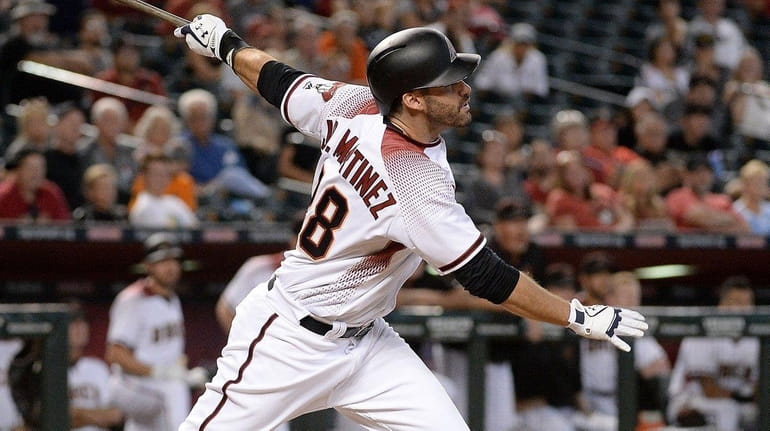Winter’s free-agency freeze boils over into spring training

J.D. Martinez still doesn't have a team for the 2018 season. Credit: Getty Images / Jennifer Stewart
TAMPA, Fla.
The bellicose company lines uttered by the commissioner. The puzzled expressions from the players, with many big names still unemployed. The suspicion of their agents.
For a sport coming off an epic World Series and a $10-billion industry gearing up for another profitable year, is this how everyone wanted spring training to start? What the heck happened this winter, anyway?
Nothing, mostly, and therein lies the problem.
The Yankees rocked the baseball world by trading for Giancarlo Stanton — a deal he orchestrated by forcing the cash-strapped Marlins’ hand — and the Angels pulled off a mild upset by luring Shohei Ohtani, the Japanese two-way threat, to SoCal. Aside from that, we’ve had a few uninspiring new deals and a historically stagnant free-agent market.
None of which seems to bother commissioner Rob Manfred or those operating MLB’s 30 teams, a group that has yet to find a need for J.D. Martinez, Jake Arrieta, Mike Moustakas, Lance Lynn or Alex Cobb, to name a few of the players still seeking jobs.
When Manfred spoke excitedly about spring training during a news conference at Tropicana Field on Thursday, he didn’t flinch when confronted by the icy response to free agents this offseason, chalking it up to basic economics.
Even if there is something more insidious at work, such as collusion — an allegation the commissioner has vehemently dismissed — proving such a claim would be extremely difficult. We’re left with trying to uncover other market factors, and it’s probably a combination of things working together to make this free-agent class one of the unluckiest groups in recent memory.
“I do think it’s tough to simplify,” said John Mozeliak, the Cardinals’ president of baseball operations. “I think just because we’ve experienced three months of this doesn’t mean you’re going to see five years of this. We just don’t know.
“But I also think teams are always going to be opportunistic, teams are always going to be looking at ways to improve. I would imagine that’s going to continue and this year is going to be looked back at as probably more of an outlier than a trend.”
With pending free agents such as Bryce Harper, Manny Machado, Josh Donaldson, Dallas Keuchel and perhaps Clayton Kershaw on schedule to be available next offseason, you would expect more money to be thrown around. Fittingly, the winter meetings will be held in Las Vegas. But that’s no consolation to the group being frozen out now, and some players believe this is evidence of baseball’s salary structure being broken.
Last year, according to Spotrac.com, MLB spent 1.4 billion on 102 free agents, with nine players signing contracts of more than three years. Thus far this year, 70 free agents have been signed for a total of $976.3 million, and only two — Yu Darvish (six years/$126 million) and Lorenzo Cain (five years/$80 million) — have deals that exceeded three years.
CC Sabathia has earned nearly $243 million in his 17-year career, and at age 37, he signed a one-year, $10-million contract to return to the Yankees. Sabathia said he’d be “panicking” right now if he were Arrieta. With the current collective-bargaining agreement locked in through 2021, he’s concerned that this might be the new norm.
“I don’t know what you do,” Sabathia said. “Maybe you shorten the years before you go to free agency. Make it four years instead of six, so guys have a chance to be in their 20s going into free agency instead of being 30. That makes a difference.”
Sounds great from a player’s perspective, but you won’t see the owners rushing to sign up for that unless the MLBPA has other negotiating chips or takes more drastic action, such as a strike, to get its point across. Agent Brodie Van Wagenen of CAA dropped a hint about such militaristic strategy earlier this month with a strongly worded statement regarding the boiling frustration among the players, going as far as to suggest a spring training boycott, which the union was smart to immediately shoot down. “There is a rising tide among players for radical change,” Van Wagenen said. “A fight is brewing.”
First, they’ll have to identify the enemy. What if teams now are more motivated to develop younger players within their own system and promote them to the majors, as the Astros did for the core of last season’s world champion?
That didn’t happen overnight, obviously. The Astros were non-competitive from 2011-14, losing at least 100 games in three straight seasons while their payroll sunk as low as $26 million in 2013. Last year, Houston spent $140 million in earning its first World Series crown but relied on a young core solidified during the rebuilding effort. For teams patient enough to try — and many seem to be lining up — the Astros have provided the blueprint.
“We all have great young players in our system and on our big-league teams,” Astros general manager Jeff Luhnow said. “And because the investment is so high in young players, they get to the big leagues fairly early. They’re still developing at the big leagues, and so swapping one of the young players out for an established veteran is not as attractive today as it would have been five years ago or 10 years ago, possibly.
“It could be that there’s just simply fewer spots because a lot of the younger players are taking up spots and they’re contributing. It doesn’t explain everything, but part of the dynamic is that we’re doing a good job as an industry developing young talent and valuing that talent.”
Look at the Yankees. While generall manager Brian Cashman has faith in the abilities of Gleyber Torres and Miguel Andujar to fill his infield vacancies at second and third, the terms of this year-old CBA deter him from going out and spending for someone like Moustakas instead. By instituting the new terms of the $197-million luxury-tax threshold, the union basically signed off on a soft cap.
There is a significant incentive to do that. By staying under $197 million, those teams not only are off the hook for paying a luxury tax this year but get to reset their rate if they go over in 2019.
That’s good news for Harper and Machado and terrible timing for the ’18 class, for which Manfred offers no apologies. Having a soft cap, however, certainly appears to have put artificial limitations on some salaries this winter.
“We bargained a market-based system,” Manfred said. “Markets operate differently year to year. It’s particularly true in our business given the different players, clubs with different needs. This market has been different in terms of timing, but we believe that players who are major-league players will eventually get signed, whenever that timetable turns out to be.”
This baseball winter has created a new definition for “eventually” and one that could have ramifications well beyond it. Time will tell if Manfred’s economics lesson actually has any semblance of truth, or if the way the sport does business has irreversibly changed.
“Does the stock market go up all the time?” Mozeliak said. “There’s volatility.”
Beneath these pleasantly sunny skies in Florida and Arizona, a not-so-quiet storm is brewing.

